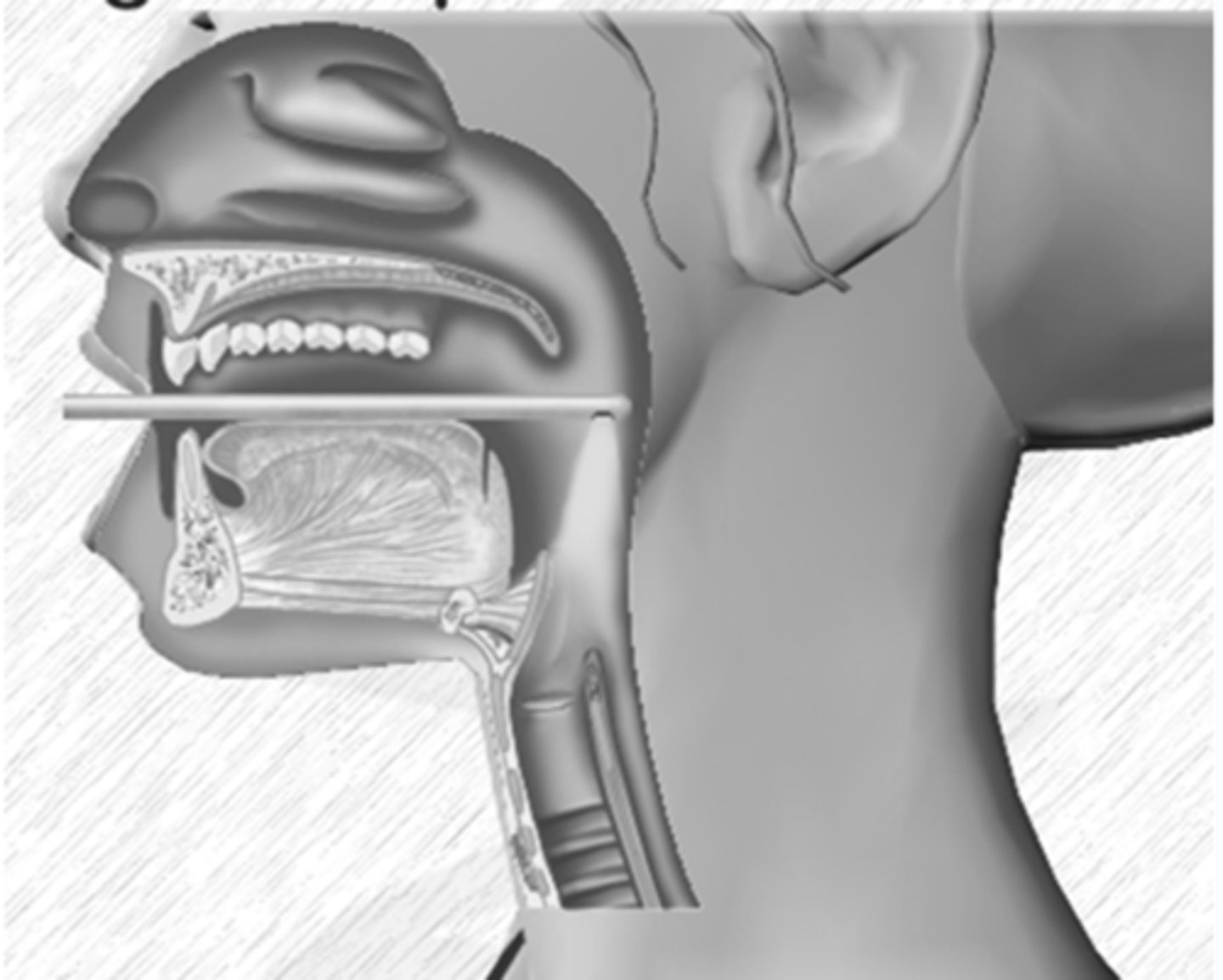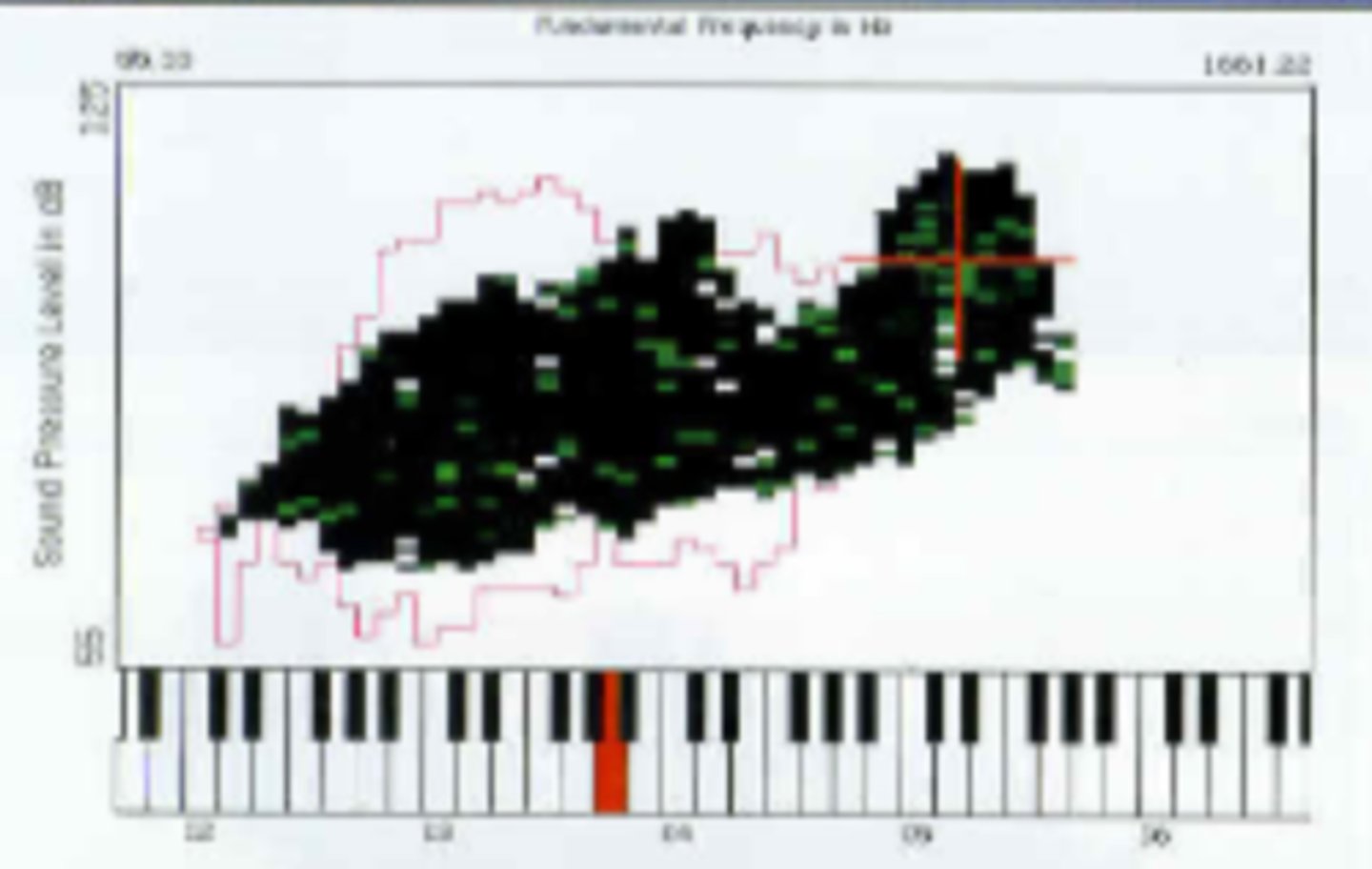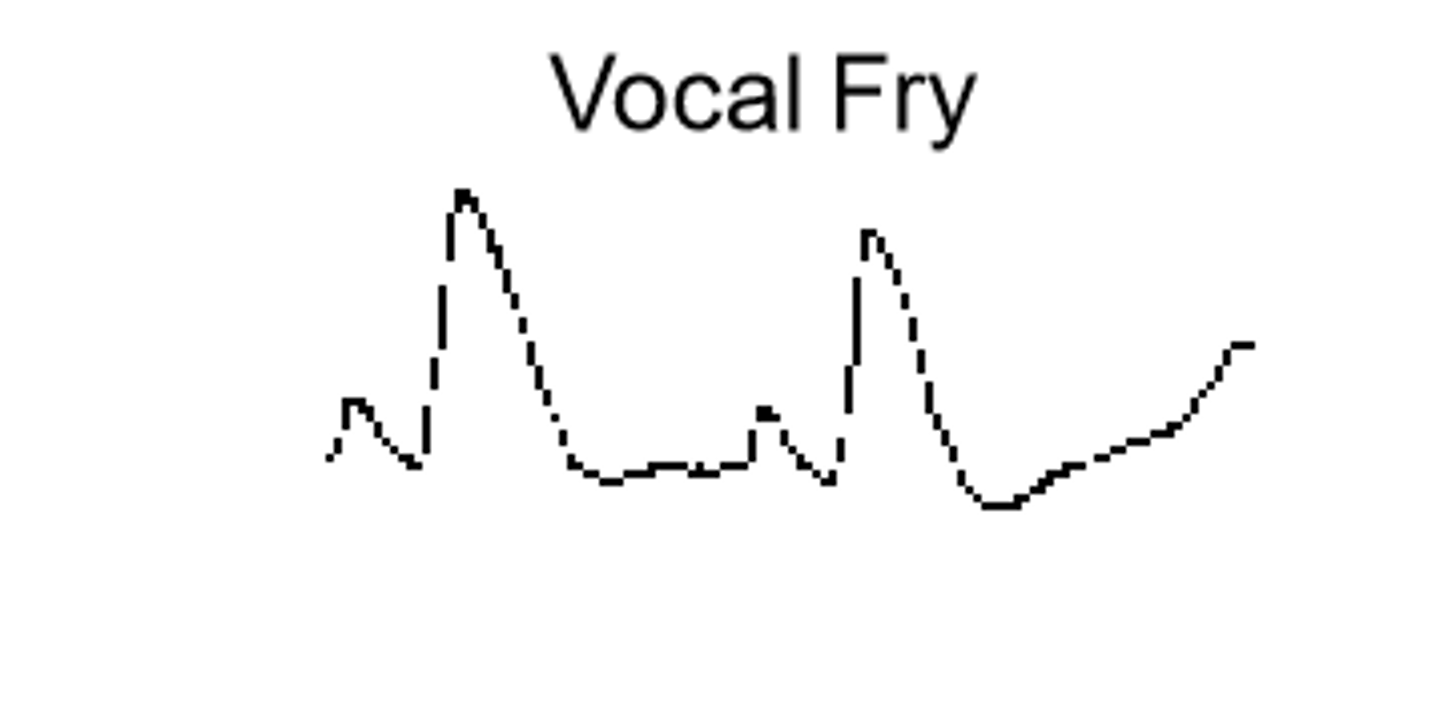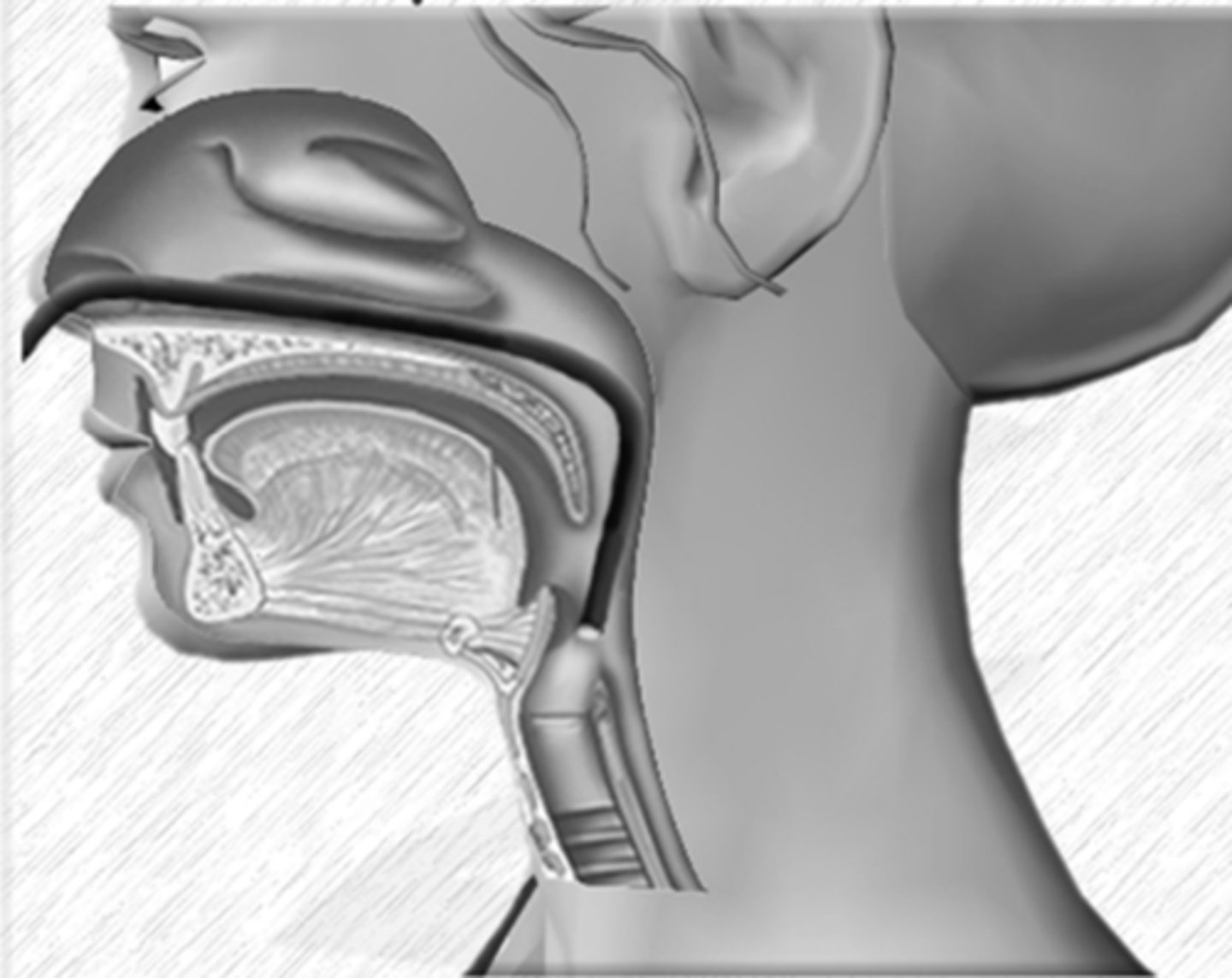CSD 353 Phonation
1/89
There's no tags or description
Looks like no tags are added yet.
Name | Mastery | Learn | Test | Matching | Spaced |
|---|
No study sessions yet.
90 Terms
rigid
this type of laryngeal endoscope creates larger, more stable, brighter images, works only a sustained vowel. Client posture is unnatural. Ideal for close views of the VF or lesion, patients who can tolerate it, and when VF vibration patterns are important to observe when strobe light is used

vocal folds
layers of tissue stretched between the arytenoid cartilages and the thyroid cartilage of the larynx. They can be abducted or adducted, stretched out or compressed. They close medially, anterior to posterior. Should be open during breathing. Close for speech, subglottic pressure causes them to vibrate and create sound.
cover
the 2 most superficial layer of the vocal folds
squamous epithelium
most flexible layer of VF, very thin layer of skin cells
lamina propria
three layers of the VF which are still pretty flexible but progressively increasing stiffness by increasing the collogen
vocal ligament
another name for the intermediate and deep lamina propria. Also called the medial edge
body
The vocals muscle, thicker and denser than the other layers. the only layer with nerve innervation, provides stability.
neurochronaxic
this theory of VF movement is now defunct. It states that nerves innervate the vocal folds and cause them to vibrate at the desired frequency. But nerves can't fire fast enough
What is the myoelastic-aerodynamic theory?
It is a theory of vocal fold movement based on muscle elasticity and the laws of airflow.
What creates the repeated pattern of opening and closing in the vocal folds according to the myoelastic-aerodynamic theory?
A consistent stream of air flows past the vocal folds.
What factors interact in the myoelastic-aerodynamic theory?
The aerodynamic properties, subglottic pressure, and transglottal flow interact with the resistance and elasticity of the vocal fold tissues.
Closed Phase: Myoelastic-Aerodynamic Theory of Phonation
-Lateral Cricoarytenoids muscles
-Internal Arytenoids muscles
-Medial compression is created and holds the folds closed near midline.
- Subglottic pressure begins to increase as expiratory forces are met by the resistance from the adducted VF.
-In order for air to flow and set the VF into vibration, the subglottal pressure must be greater than the supraglottalpressure.
Opening Phase: Myoelastic-Aerodynamic Theory of Phonation
-As subglottic pressure builds, it becomes stronger than the resistance of the closed VF and forces them apart.
-Air wants to move to an area of lower pressure, so it moves upward through the glottis.
- The air sets the VF into vibration (like the tuning fork)
-This sound ("the glottal spectrum") is transmitted and thenmodified further through the vocal tract.
Closing Phase: Myoelastic-Aerodynamic Theory of Phonation
- Due to the elasticity of the VF, they begin to recoil back to midline.
- Respiratory drive is relatively constant so the same amount of air is going through a narrower constriction.
- As the glottis becomes more narrow, airflow increases and air pressure decreases.
- The decrease in air pressure also helps to close the VF.
Bernoulli Principle
An aerodynamic law stating that an increase in the velocity of air decreases air pressure
flow (positive) = pressure (negative)
voice and fundamental frequency
- During speech, the VF vibrate hundreds of times per second
-.The vibration creates a complex periodic sound wave.
-The rate at which the VF vibrate is the F0 and corresponds to the perceived pitch of voiced sounds.
-The rate of vibration depends on the length, mass, and tension of the VF.
- Changes in F0 is primarily determined by the tension of the Vocalis and contraction of the Cricothyroid muscle.
- So...the greater the mass and the less the tension, the slower the VF will vibrate.
PTP
this refers to the minimum amount of subglottic pressure to set the VF into motion. Varies with loudness and pitch.
- ranges from ~2-3 cm H20 for a soft voice
phonation threshold pressure
this is what PTP stands for
greater PTP when VF have more medial compression.
periodic
repeated pattern for sound waves where each period is one cycle of VF motion.
aperiodic
one reason why VF aren't pure-tones, a not perfecting repeating pattern
perturbation
one reason why VF aren't pure-tones, frequency and amplitude vary from cycle to cycle
harmonics
one reason why VF aren't pure-tones, they include other frequencies on top of the fundamental frequency, due to the vocal tract
frequency
average F0, frequency variability, frequency range, and jitter are all ways to measure this
intensity
average amplitude, amplitude variability, dynamic range, shimmer are all ways to measure this
noise
extra aperiodic sound
180-250 Hz
the range for average F0 for males
175-266 Hz
the range for average F0 for females
10-35 Hz
the range for SD frequency variability in conversation
< 3Hz
the range for SD frequency variability in a sustained vowel
80-700 Hz
this frequency range is generally expected for males
135-1100 Hz
this frequency range is generally expected for females
2.4
this is the average number of octaves a period
30-48 ST
this is a range of the average vocal range in semitones
<1%
the norm for jitter
Jitter
frequency perturbation
RAP = Relative Average Perturbation (3 cycles)
60-80 dB
the dB SPL norm range for average amplitude of typical voice
10-15 dB
the SD dB SPL norm range for amplitude variability
50-115 dB
the dB SPL norm range for dynamic range
<5%
the norm for shimmer
fundamental frequency
the rate at which the vocal folds are vibrating. There may be harmonics on top of it, but this is still the pitch that is heard
frequency range
this describes the max and minimum frequencies during a phonation sample
frequency variability
this describes SD of frequency changes over the course of a sample
How is loudness increased in voice production?
By increasing the amount of subglottal pressure.
What builds up subglottal pressure?
Increasing inspiratory capacity and medial compression of the vocal folds.
What happens to the vocal folds when subglottal pressure increases?
The folds are blown apart more forcefully and recoil with more force.
What effect does increased amplitude of vibration have on sound?
It generates a louder sound wave.
How does intensity relate to fundamental frequency?
Increases in intensity occur with increases in fundamental frequency.
semitones
these reflect the perceptual pitches that can be produced. Like notes, 12 in an octave
50-60 dB
dB SPL for "quiet" voice
105 dB
dB SPL for "loud" voice
vocal range profile
-Phonetogram
- Dynamic Range x Fundamental frequency (db SPL x F0)
- Sustained Vowel, loud/soft at different frequencies
- Upper Contour = Mac intensity
-Lower contour = min intensity. Each frequency attempted
Dervies: Min and max: frequency & amplitude Range: Frequency & Amplitude Average Amplitude

What does vocal quality refer to?
Voice = acoustics and quality.
What are the dimensions assessed in vocal quality?
Breathiness, Roughness, Pitch, Loudness, Resonance, Strain
How does vocal fold vibration affect vocal quality?
Quality is related to how the vocal folds vibrate (Hypoadduction / Hyperadduction).
What is velopharyngeal closure related to in vocal quality?
Resonance: Hyponasal / Hypernasal.
How is vocal quality measured perceptually?
Breathy, Rough, Pitch, Loudness, Strain, Weak Number and Categorical Rating scales.
hypoadduction
difficulty making the vocal folds close strongly enough or long enough for normal phonation that results in a weak, breathy voice that often deteriorates with increasing amounts of vocal use throughout the day
hyperadduction
Excessive movement toward the midline, often resulting in a tense voice quality.
hyponasal
reduced nasal resonance; sounds flat
Hypernasal
too much nasality
monotone
this is the layman term for low amplitude and frequency variability
intensity variability
the change in amplitude over time
dynamic range
the loudest and softest voices possible
variability
larger scale changes in frequency or amplitude over time
HNR
this ratio refers to the amount of aperiodic sound a speaker produces. High means a purer voice and low means lots of noise
register
portions of the total F0 range. Singers call them chest voice, head voice, and falsetto. Each one has a different manner of VF vibration. Transition is obvious with jitter/shimmer
pulse
this is low range of F0, 25-28 Hz. VF are short and thick, minimal tension, low PTP, incomplete closure. Cover: Lax, CT: relaxed. TA: contracted
modal
this is the typical range of F0, cover and body vibrates, more PTP than pulse
falsetto
this is very high F0. Less movement in body. VF are long, stiff, thin, edge is sharp. Superficial LP: lax, middle and deep LP: tense. VF don't completely close, highest PTP
electroglottograph
EGG - electrodes on the neck- measures impedance which corresponds with vocal fold contact
impedance
the difficulty of the electrical current to travel between the electrodes. There is higher during the open phase and less during the closed phase
Lx waveform
the output of the EGG

peak
the point of max closure, top of a waveform
trough
the bottom of the waveform, the point of most open VF
contact quotient
the duration of the closed phase divided by the period. The result is a percent of the cycle that the VF are closed. CQ increases with increased pitch
amplitude
on the Lx waveform this is measured in volts and represents the amount of closure/opening of VF
breathy
this kind of voice looks like a really long opening duration, low amplitude peak
hyperadduction
this kind of voice results in a long closing phase of the Lx waveform
pulse

modal

falsetto

laryngeal endoscopy
the method of viewing the VF where a probe with a camera and a light is sent down through the nose or mouth and you can see the VF on the screen
steady light
a steady halogen light is shined down on the VF, and you can see the tissue and muscular opening and closure. But the vibration of phonation is too fast to see.
stroboscopy
the flashing xenon light. Timing triggered by F0 of the voice as determined by a contact microphone or EGG
still
this type of stroboscopy is when the rate of flashing is locked, and you can see only one phase, because the light flashes at the same point of the vibration
flexible
this type of laryngeal endoscopy creates more natural productions but is more invasive. Subject to disruptive vertical movement, making it more difficult to achieve a stable image. May create a darker image. Ideal when the rigid is not possible, connected speech must be observed, vocal tract movements are important, velopharyngeal function is of interest

endoscopy
visual examination of a body cavity or canal using a specialized lighted instrument called an endoscope
jitter
frequency perturbation. Changes in frequency cycle to cycle
shimmer
amplitude perturbation. Changes in amplitude cycle to cycle
acoustic
these measures are objective, includes: frequency, intensity, perturbation, nasalance, HNR